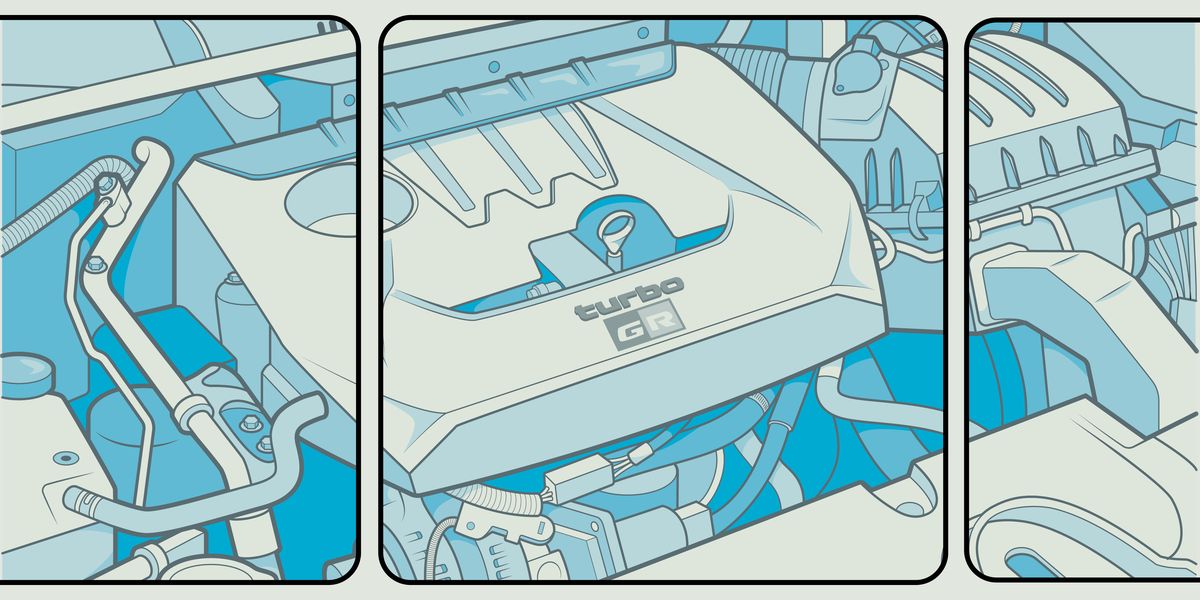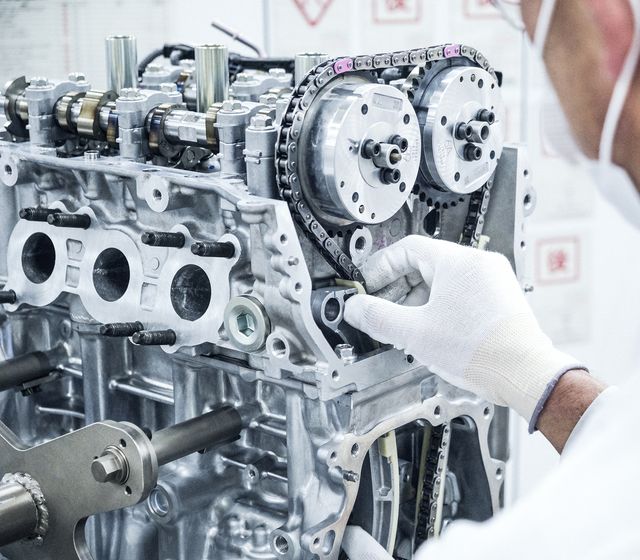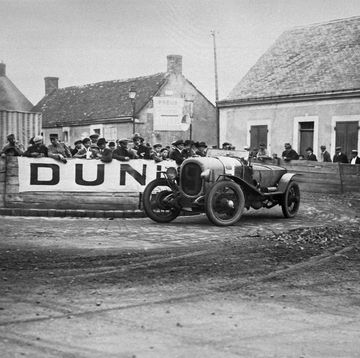If you're designing an engine for maximum horsepower, conventional wisdom suggests you want more revs, and typically, that means more cylinders. We don't drive around in one-cylinder cars, after all. More cylinders means many components of an engine's rotating assembly—pistons, rods, valves, camshafts, crankshaft, etc.—can be made lighter, reducing inertia, and allowing for higher engine speeds. For a given displacement, the very basic thinking is that you want as many cylinders as physically possible.
However, engine design doesn't happen in a vacuum. Very basic thinking doesn't apply. We also don't drive around in 20-cylinder cars. You have so much to consider in creating the ideal engine for a specific application, and that often leads you down a very interesting path. For the engineers at Toyota Gazoo racing, that led to a 1.6-liter turbo three-cylinder.
The three-cylinder is, of course, Toyota's G16E-GTS, which first debuted in the GR Yaris, and made it to America in the new GR Corolla. In the Corolla, the engine makes 300 hp and 273 lb-ft of torque and 295 lb-ft in the limited Morizo edition. "At first, this engine was developed for the Rally2 category," GR Corolla chief engineer Naoyuki Sakamoto tells Road & Track. "Our engineers were focused on how to maximize engine output to meet the homologation. So in that case, we tried to find out which engine rpm range is ideal for the Rally2, then figured out how to maximize performance."
Rally2 is one rung below the top-level Rally1 in FIA-sanctioned rally competition. Think LMP2 to Hypercar, to use a sports-prototype analogy. Like most racing formulas based on production cars, FIA Rally2 has engine design specifications. In this case, four-cylinders maximum, 1630 cc displacement, and a turbocharger with a 32 mm intake restrictor. A minimum weight of 2712 pounds and a maximum weight-to-power ratio of 9.2 pounds/hp means a maximum output of 290 hp. (Note that unlike modern sports-car racing, rally does not have Balance of Performance, where intake restrictors of various sizes and ballast are used to balance out the speed of various competing cars.)
While a basic understanding of engine-design theory might lead you down the path of using the most cylinders allowed, Toyota took a different path than any other Rally2 constructor. Sakamoto says that the idea was to maximize bore size, and fewer pistons for a given displacement means a larger bore with three cylinders is possible than with four cylinders.
Sakamoto explains that the larger bore also allowed for larger exhaust valves, which are especially important for Rally2 given the mandated intake restrictor. At its very core, an engine is an air pump, and the more air you get in and out, the more power you get. If your intake flow is limited, it's important to try and compensate with exhaust flow. Greater exhaust flow also helps spin up to the turbocharger more quickly, improving drivability.
Three-cylinder engines have another advantage over four-cylinders in that there's no exhaust-gas interference creating unwanted backpressure as there would be in a four-cylinder. Sakamoto says this meant Toyota didn't have to go down the route of using a complicated twin-scroll turbocharger to get desired power levels while also trying to mitigate backpressure. In the GR Corolla, the unique three-tailpipe exhaust system further reduces backpressure compared with the Yaris.
It's worth noting that Toyota is not the first to develop a rally three-cylinder. M-Sport, the de facto Ford works rally team, launched a 1.0-liter three-cylinder Fiesta for what is now called the Rally4 class back in 2018.
We also need to make a brief aside to talk about Toyota's Yaris rally cars. Many of you probably know that the non-U.S.-market GR Yaris was created as a homologation special for a top-level 2021 WRC car that never ended up racing as a result of the COVID-19 pandemic. It was extensively revised over the standard Yaris, with a new three-door bodyshell and unique independent rear suspension. But that car would've never used a three-cylinder, as the regulations for 2021 stipulated a 1600-cc four-cylinder. Toyota's new hybrid GR Yaris Rally1 car uses a four-cylinder from its old WRC car, too. So while the GR Yaris is a homologation special, its engine wasn't meant to be homologated for the car you think. And to add to the fun, the GR Yaris Rally2 won't race until next year.
Sakamoto isn't oblivious to the shortcomings of a three-cylinder compared with a four. The biggest issue with a triple is vibration, as when one piston reaches top-dead center, the other two are 120-degrees away from either top-dead or bottom-dead center. This creates a twisting force, essentially the engine trying to flip itself over on its side, requiring a balance shaft. The balance shaft naturally adds complexity and also increases the weight of the rotating assembly, decreasing its ability to rev. Still, given all the parameters Toyota wanted to hit, the three-cylinder was the right solution.
(While most three-cylinder engines use a balance shaft, some automakers have creative solutions to get around them. Ford's 1.0-liter intentionally imbalances the flywheel for the same effect. Meanwhile, most four-cylinder engines get away with having no balance shaft, but Mitsubishi used them on its large-displacement inline-fours of the Seventies and Eighties. Porsche licensed the tech for its own big-bore fours, like in the 944.)
To help counter the weight added by the balance shaft and to ensure reliability, Toyota uses a lot of strong, lightweight materials in the rotating assembly. Sakamoto says the pistons in the GR Corolla—unique even to what's used in the GR Yaris—are around 30 percent lighter than the average automotive piston, while the exhaust valves are hollow and sodium-filled and the exhaust camshaft is made from forged steel. The single ball-bearing turbo is integrated directly into the exhaust manifold, which helps save weight and reduce plumbing length, helping the turbo produce its 25.2 psi of boost (26.3 psi for the Morizo) faster.
While the G16E-GTS is unlike a lot of Toyota engines, Sakamoto tells us it benefits from a lot of the learnings of the super-efficient Dynamic force engines developed as part of Toyota's New Global Architecture (TNGA) platform. One of the main focuses for TNGA engines is ensuring quick combustion to boost efficiency without causing knocking. The three-cylinder also uses both port- and direct-fuel injection, a longtime Toyota hallmark.
I've had two chances to experience the G16E-GTS, once in a GR Corolla Morizo Edition at our Performance Car of the Year test last year, and a few weeks ago in the base Core model. It's a hilarious engine, perhaps the best thing about the GR Corolla. It often feels like a turbocharger with some engine attached, but in a good way. There's not a ton of lag, and the boost threshold is fairly low, but once the turbo is going, you really know it. It's astonishing to think a three-cylinder can do this. Its specific output of 187.5 hp/liter matches that of a Bugatti Chiron's, and it reaches the magic 100 hp/cylinder number. Of course it isn't the smoothest thing in the world, but the GR Corolla is no luxury car. It's the type of car that needs a characterful engine, and this engine has that in abundance.
The G16E-GTS has an interesting parallel with a very different race engine, the Cosworth DFV. Back in the mid-Sixties, the prevailing wisdom was that for Formula 1's displacement-limited engine formula, the more cylinders the better. Ferrari, Maserati, and Honda all ran V-12s, while BRM developed a 16-cylinder for the 3.0-liter engine rules that came into effect in 1966. A year later, it probably seemed odd when Cosworth showed up with a V-8. But, the DFV was lighter, smaller, simpler, and more robust than its 12- and 16-cylinder counterparts, and the V-8 went on to be the most successful F1 engine of all time. And by some margin.
Cosworth knew that the engine was just part of the car. It was worth sacrificing some peak power potential for a better overall package, worth it to cut cylinder count. Toyota engineers get the same thing, and in the process, they've created one of the coolest road and race engines we've ever seen.
A car enthusiast since childhood, Chris Perkins is Road & Track's engineering nerd and Porsche apologist. He joined the staff in 2016 and no one has figured out a way to fire him since. He street-parks a Porsche Boxster in Brooklyn, New York, much to the horror of everyone who sees the car, not least the author himself. He also insists he's not a convertible person, despite owning three.
















